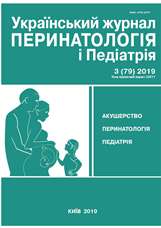Evaluation of the level of reduced proteins and their recipers in the blood syrobal in children with bronchial asthma, depending on indicators of the external respiratory function
DOI:
https://doi.org/10.15574/PP.2019.79.15Keywords:
asthma, children, iron proteins, respiration functionAbstract
Purpose — evaluate the level of iron-containing proteins and their receptors in blood serum of children with bronchial asthma, depending on the indicator of the function of external respiration.Patients and methods. In accordance with the goal, we examined 227 children aged 6 to 17 years old with bronchial asthma. The total number of iron in serum, total iron binding capacity, latent iron binding ability, saturation coefficient of transferrin, level of ferritin, content of soluble receptors to transferrin (sTfR), sTfR/log index Ferritin (>1.5 — latent iron deficiency). The function of external respiration (FEV1) investigated by spirography on the Spirolab III.
Results. The conducted study determined that microcytosis in children with asthma, with severe degree of airway obstruction, was 53.76% more frequent than in patients with normal cytosis. According to our data, the indicators of ferrokinetics in the examined children with asthma depended on the degree of obstruction of the respiratory tract. Thus, in the group of children with an FEV1 index of >80%, the saturation rate of transferrin by iron was 10.4% lower; in the group of children with an indicator of FEV1 65–80% by 18.48% lower; in the group of children with FEV1 50–65% by 24.79% lower and in the group with FEV1 less than 50%, the saturation rate of transferrin by iron was 28.59% lower in relation to healthy children.
Conclusions. In children with asthma, with severe and moderate degrees of airway obstruction (according to the FEV1), iron deficiency was found to be 10.1 and 5.02 times higher than in patients with an FEV1 of 80% or more. Among the indices of iron metabolism, the most significant changes were the change in the saturation coefficient of transferrin by iron, which confirms the presence of a significant positive correlation between the coefficient of saturation of transferrin by iron and FEV1 (rxy=0.621 (p=0.026)) and moderate association with PEF (rxy=0.422 (P=0.033)). There is also a positive correlation between levels of ferritin and the value of FEV1 (rxy=0.258 (p=0.024)).
The research was carried out in accordance with the principles of the Helsinki Declaration. The study protocol was approved by the Local Ethics Committee (LEC) participating institution. The informed consent of the patient was obtained for conducting the studies.
No conflict of interest were declared by the authors.
References
Bilovol OM. (2015). Vid metabolizmu zaliza — do pytan farmakolohichnoi korektsii yoho defitsytu. Liky Ukrainy. 4 (190): 46—51.
Dvoretskiy LI. (2014). Anemiya u bolnyih hronicheskoy obstruktivnoy boleznyu legkih: komorbidnost ili sistemnoe proyavlenie? Pulmonologiya 2: 5—11.
Fedortsiv OE, Vasylieva NA, Voloshyn SB. (2014). Funktsiia zovnishnoho dykhannia u ditei z bronkhialnoiu astmoiu. Aktualni pytannia pediatrii, akusherstva ta hinekolohii. 1.
Eissa SA, Mohammad AAE, Ibrahim SAE, Abd-Elgwad ER, Soliman NSAE. (2016). Iron deficiency anemia as a risk factor in childhood asthma. Egyptian Journal of Chest Diseases and Tuberculosis. 65 (4): 733—737. https://doi.org/10.1016/j.ejcdt.2016.05.004
Elsayed WA, Essa E. (2017). Iron deficiency anemia, serum iron in children with bronchial asthma. Zagazig University Medical Journal. 23 (1). https://doi.org/10.21608/zumj.2017.4682
Hale LP, Kant EP, Greer PK, Foster WM. (2012). Iron supplementation decreases severity of allergic inflammation in murine lung. PLoS One. 7 (9). e45667. https://doi.org/10.1371/journal.pone.0045667
Madu AJ, Ughasoro MD. (2017). Anaemia of chronic disease: an in-depth review. Medical Principles and Practice. 26 (1): 1—9. https://doi.org/10.1159/000452104; PMid:27756061 PMCid:PMC5588399
Downloads
Issue
Section
License
The policy of the Journal “Ukrainian Journal of Perinatology and Pediatrics” is compatible with the vast majority of funders' of open access and self-archiving policies. The journal provides immediate open access route being convinced that everyone – not only scientists - can benefit from research results, and publishes articles exclusively under open access distribution, with a Creative Commons Attribution-Noncommercial 4.0 international license(СС BY-NC).
Authors transfer the copyright to the Journal “MODERN PEDIATRICS. UKRAINE” when the manuscript is accepted for publication. Authors declare that this manuscript has not been published nor is under simultaneous consideration for publication elsewhere. After publication, the articles become freely available on-line to the public.
Readers have the right to use, distribute, and reproduce articles in any medium, provided the articles and the journal are properly cited.
The use of published materials for commercial purposes is strongly prohibited.

